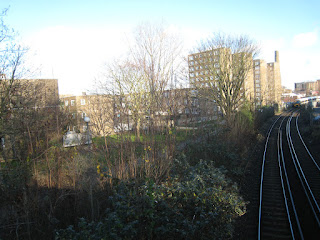Whilst the impression may be an inexorable improvement, it seems rather that this may be part of London's natural ebb and flow. So, I thought I'd explore some of London's less-loved areas, keeping an attentive eye out for former grandeur. Hence Woolwich.
Approaching from the West, the impeccably-dressed cyclist comes across the William Morris Estate. God knows why it's named after a proponent of local crafts and workmanship, as the estate is made of Danish system-built prefab point blocks and slabs (the same type that collapsed at Ronan Point in '68).
The estate map looks like a screenshot from the original Star Wars arcade machine.
Underlining the meanness of the site, the mainline railway track cuts through the estate but doesn't stop there.
There's the train you can't get on.
This type of building is wildly unfashionable. But on a sunny winter's morning, the well-endowed cyclist could nearly infer the architect's efforts to play with light.
Moving further west, one comes across the rather attractive water feature of stagnant rain collecting on the happy space / roof of the communal garage block.
A bit further towards the town, the devastatingly-charismatic cyclist passes through a mish-mash of Victorian, 30s and 50s housing, and chances upon a particularly exciting public house, which is clearly the centre of the local community.
Wow, that many forthcoming events?
A touch further West, the witty and yet international homme en bicyclette chances upon the first real signs of lost glory, in the shape of some superb 30s buildings, now sadly in really horrible states of disrepair. Gateway House, a rare piece of Streamline Moderne (which might be my favourite type of Art Deco), was once an Odeon, and is now a New Wine Church.
Why do I always have lampposts in my photos?
Across the road is the Grade II-listed Granada, which was once billed as the 'most romantic theatre ever built'. It's now a Gala Bingo.
Oh hai lamppost (which is strangely of a different design to the one on the other side of the road).
The Royal Arsenal Cooperative, another great bit of Deco, is now derelict.
Sob.
Passing through the mainly-50s pedestrianised parade of shops, the plucky adventurer comes across a timewarp Sainsbury's, all brown and orange and low-ceiling'd. It looks in my photo as if the block of flats on the left is connected by a flying walkway to the lift tower of the multi-storey carpark above Sainsbury's... Surely that can't be right. Surely.
All shops in Woolwich must be clearly signalled by massive orange arrows (Bye law 1.26.2).
Saluting any picture of Cameron on the TV is obligatory (Bye law 1.26.3).
The teasingly-wonderful urban raconteur has, of course, saved the best of Woolwich till last. In the middle of the shops, an observant and well-muscled chap can find the area's principal tourist attraction - the world's 3000th McDonald's - the very first in the UK. It's like looking upon the face of God.
Mr Ray A Kroc later went on the manufacture a range of vile rubber shoes.











No comments:
Post a Comment